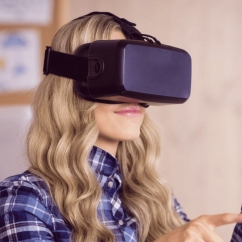Jewelry ECOMM Tech
The Augmented Engagement Ring December 04, 2018 (0 comments)
 Physical reality often has drawbacks, particularly for a jewelry retailer. Stocking pieces can be an expensive, time-consuming process, and as tastes change, the problems of storage rise to the forefront. When can pieces be rotated in and out of display? How can retailers keep their products safe?
An answer for the 21st century retailer is to simply abandon physical reality entirely.
Physical reality often has drawbacks, particularly for a jewelry retailer. Stocking pieces can be an expensive, time-consuming process, and as tastes change, the problems of storage rise to the forefront. When can pieces be rotated in and out of display? How can retailers keep their products safe?
An answer for the 21st century retailer is to simply abandon physical reality entirely.
 We haven’t yet reached a state of affairs where we can live in a parallel digital reality, but technology has reached a point where we can superimpose an artificial reality on the world around us. And, fortunately for us, an example of this advancement is at hand: The careful observer of trends may have noticed a recent preoccupation among younger smartphone users—Pokémon GO.
Pokémon GO was a game developed in 2016 as a joint project between Niantic, Inc. and video game powerhouse Nintendo. The premise of the game is simple: Players download the game as an app on their phones. Utilizing a smartphone’s connection to Niantic’s databases and its built-in camera, players see their real-life surroundings on the phone screen. The game then takes advantage of a smartphone’s gyroscope and its own proprietary algorithms to determine where the “ground” is. On the ground captured on the screen (which can be bodies of water, different kinds of pavement or grass, etc.), Niantic places one of the Pokémon creatures from Nintendo’s games. This creature, superimposed on the landscape, can be interacted with by the player-cum-owner of the smartphone.
Retailers who have read this far may not understand what a video game has to do with their business, but the answer lies not in the game, but in the technology of which Niantic and Nintendo took advantage.
Known as “augmented reality”, this technology is allowing for a fusion of the all-digital world with the physical one in surprising and inventive ways, and Pokémon GO has merely been the most visible face of this revolution in technology. Augmented reality, however, is merely a subset of a larger trend called “computer-mediated reality”. Computer-mediated reality comes in a multiplicity of forms, and its subset of augmented reality includes algorithms that superimpose objects on reflections or camera shots. Additional technologies that can be considered subsets of computer-mediated reality include concepts like holograms and devices that directly intermingle human sensory input with a constructed reality (such as virtual-reality headsets).
Retailers may currently be aware of virtual reality and holograms, as those concepts date back to the 1950s and 1940s, respectively, but breakthroughs in VR and holographic development are making these technologies a game-changer in how people interact with their realities, and economies of scale have rendered them more accessible for all audiences.
Both Forbes (“How Brands Can Win With Millennials In The Experience Economy”, July 2017) and CNBC (“Millennials are prioritizing 'experiences' over stuff”, May 2016) have noted that millennial shoppers are moving away from “shopping for products” and opting, instead, for “shopping as experience”. It’s impossible for jewelry retailers to completely divorce themselves from products, but by turning to cutting-edge, interactive computer-mediated realities like augmented reality, VR, and holograms, retailers can rebrand themselves as an experience-driven pursuit that merely ends in a product being purchased.
The canny retailer, rather than viewing computer-mediated reality as a toy, sees its subsets as a method of creating a brilliant experience that draws millennial shoppers into a brick-and-mortar storefront, which is the end goal for any retailer looking to maintain its sales.
We haven’t yet reached a state of affairs where we can live in a parallel digital reality, but technology has reached a point where we can superimpose an artificial reality on the world around us. And, fortunately for us, an example of this advancement is at hand: The careful observer of trends may have noticed a recent preoccupation among younger smartphone users—Pokémon GO.
Pokémon GO was a game developed in 2016 as a joint project between Niantic, Inc. and video game powerhouse Nintendo. The premise of the game is simple: Players download the game as an app on their phones. Utilizing a smartphone’s connection to Niantic’s databases and its built-in camera, players see their real-life surroundings on the phone screen. The game then takes advantage of a smartphone’s gyroscope and its own proprietary algorithms to determine where the “ground” is. On the ground captured on the screen (which can be bodies of water, different kinds of pavement or grass, etc.), Niantic places one of the Pokémon creatures from Nintendo’s games. This creature, superimposed on the landscape, can be interacted with by the player-cum-owner of the smartphone.
Retailers who have read this far may not understand what a video game has to do with their business, but the answer lies not in the game, but in the technology of which Niantic and Nintendo took advantage.
Known as “augmented reality”, this technology is allowing for a fusion of the all-digital world with the physical one in surprising and inventive ways, and Pokémon GO has merely been the most visible face of this revolution in technology. Augmented reality, however, is merely a subset of a larger trend called “computer-mediated reality”. Computer-mediated reality comes in a multiplicity of forms, and its subset of augmented reality includes algorithms that superimpose objects on reflections or camera shots. Additional technologies that can be considered subsets of computer-mediated reality include concepts like holograms and devices that directly intermingle human sensory input with a constructed reality (such as virtual-reality headsets).
Retailers may currently be aware of virtual reality and holograms, as those concepts date back to the 1950s and 1940s, respectively, but breakthroughs in VR and holographic development are making these technologies a game-changer in how people interact with their realities, and economies of scale have rendered them more accessible for all audiences.
Both Forbes (“How Brands Can Win With Millennials In The Experience Economy”, July 2017) and CNBC (“Millennials are prioritizing 'experiences' over stuff”, May 2016) have noted that millennial shoppers are moving away from “shopping for products” and opting, instead, for “shopping as experience”. It’s impossible for jewelry retailers to completely divorce themselves from products, but by turning to cutting-edge, interactive computer-mediated realities like augmented reality, VR, and holograms, retailers can rebrand themselves as an experience-driven pursuit that merely ends in a product being purchased.
The canny retailer, rather than viewing computer-mediated reality as a toy, sees its subsets as a method of creating a brilliant experience that draws millennial shoppers into a brick-and-mortar storefront, which is the end goal for any retailer looking to maintain its sales.



